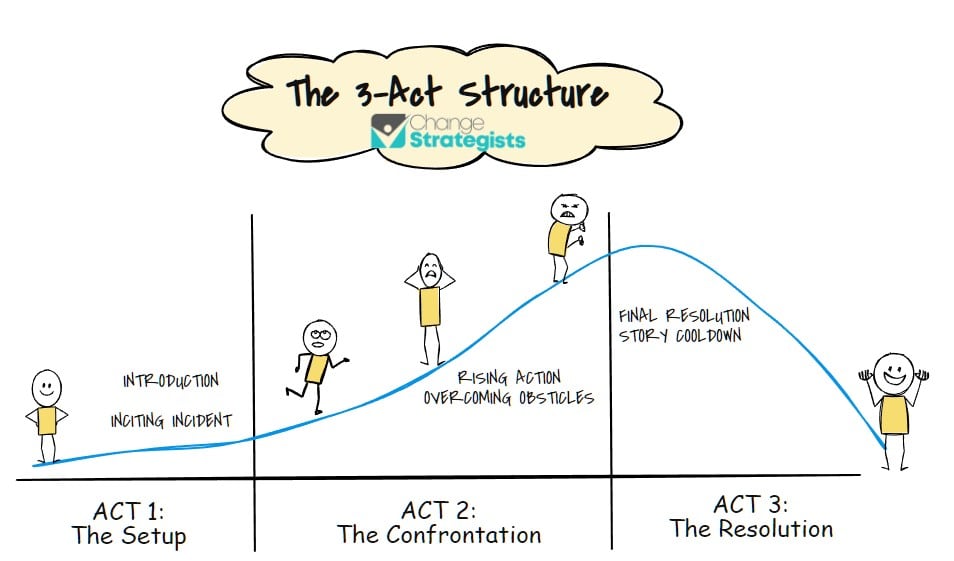Stories compel emotion, and that ultimately compels our actions. Storytelling works great for wowing your customers, but what about using them to inspire your employees?
Organizational narrative examples include history, mission, vision, change, and success narratives. These are designed to inspire changes and employees through the power of storytelling.
Building narratives goes beyond just marketing efforts that entice your customers to engage with you. Organizational narratives can drive your internal communities by giving them a sense of purpose and direction. So, what is organizational narrative, and how do you build one? Let’s explore this and more below.
What is an Organizational Narrative?
An organizational narrative is the story that a company tells about itself. This story should include the company’s history, its mission and values, and how it plans to achieve its goals. A well-crafted organizational narrative can help managers to communicate their vision for the company, inspire employees and build loyalty among customers.
Organizational narratives are built on a foundation of strong storytelling. Storytelling is one of the most powerful tools available to managers because it has the ability to engage listeners emotionally and create lasting memories. When used effectively, stories can convey complex ideas quickly and clearly, making them an ideal tool for communicating your company’s strategy or explaining new initiatives.
The importance of storytelling in business cannot be understated. A story can be developed to compel a certain action from the internal teams within an organization. While businesses often value complex data like numbers and set processes, stories are more emotion-driven. A central narrative is the basis of all the surrounding smaller and supporting narratives.
According to John Hagel – author of “The Power of Pull,” a strong company narrative always answers the following three questions:
- Why are we here?
- What is it that we can accomplish?
- How do we get together to accomplish it?
Organizational narratives are an informal way to pass on a brand’s story, values, culture, and norms. New ideas and changes are often met with less resistance when supported by a story. Here are some examples of the most common kinds of narratives used by organizations to strengthen their identity and bring their workforce together:
Example 1 – History Narrative
Every company has a story of how and why it was formed. A company history narrative is a story of how the founders created it, what problems they were solving, and what their original aspirations and goals were for the company.
This information helps employees and internal teams bond with the company and understand the true purpose behind the products or services they work on a day-to-day basis. It also helps them understand the challenges the organization had to overcome to be where it is today and to create a roadmap for success in the future.
A history narrative is also an excellent marketing tool and can be a part of your brand book or even campaigns that help your customers form a human connection to your brand.
Example 2 – Mission, Vision, and Value Narrative
Your mission, vision, and value statements may look great on paper, but they lose their impact if there are no real anecdotes or events to support them.
A good mission, vision, and values narrative gives your time something to bond over and inspires them to do better. These three narratives are what form your brand story, from where you are to where you aspire to be.
Example 3 – Success Narrative
Success is the ultimate goal for any project or initiative for an organization. However, achieving success is a complete journey.
This journey can become a narrative that inspires other employees and shows them the steps taken to achieve success in the first place.
These stories also demonstrate unique ways of solving problems and prove that the organization can produce the results it promises.
Example 4 – Change Narrative
Changes within an organization are inevitable, and they happen quite often in today’s technology-driven business landscape.
Changes are almost always met with resistance. In this situation, a good change narrative defines why the change is so important to get the organization to its desired state.
A change narrative will include the how and what and, most importantly, the “why” behind the transition. This will help employees understand why change is needed and also get them involved in the process.
How to Create an Organizational Narrative?
An organizational narrative is the story that a company tells about itself. It is how the company presents itself to the world, and it shapes how people understand and remember the organization.
A good organizational narrative will be clear, concise, and compelling. It should explain what the organization does, why it exists, and what makes it unique. An effective organizational narrative will also evoke emotion by sharing stories of triumphs and challenges overcome.
You may think that most companies already have narratives built, but more often than not, these stories stay in the heads of the leadership and never transcend to the workforce or the customers.
Here is an easy and brief step-by-step guide to help you conduct a strong narrative for your company:
Step 1 – Identify the Narrative
You will begin by creating a list of all the existing stories and narratives. This starts with identifying why you need a narrative or why you need to change it.
For example, you may already have a narrative in place, but due to an impending change in the organization, you now need to mold it to align with the company’s new values and direction.
Once you identify why the narrative is needed, the next steps become easy to execute.
Step 2 – Collaborate
Get the most creative heads in the company together and start designing how the narrative will flow. This is basically you deciding on the structure and what you want to achieve through them.
Step 3 – Craft Stories
Now that you know the purpose behind the narrative and the structure you want to implement. It is time to start gathering supporting stories and crafting the final one. Ensure the story is impactful and relevant to the company’s goals.
When storytellers tell stories, they use a three-act structure. The first act is the setup, in which the narrator introduces the characters and sets up the conflict. The second act is the development, in which the consequences of the conflict are revealed and complications arise. The third act is the resolution, in which everything comes to a head and either everyone winds up happy or unhappy.
The three-act structure is a popular tool for telling stories because it allows a story to build tension and suspense until finally something happens that resolves the conflict. It also makes it easy to predict how things will turn out: you know what will happen in the middle, but you don’t know what will happen at the end.

But this structure isn’t limited to just storytelling; it can be used when planning anything from presentations to business negotiations. By breaking a complex task down into small—but achievable—steps, we can create momentum and momentum builds energy until we reach our goal.
And just as with storytelling, using a three-act structure can help us organize our thoughts so that we’re clearer about what needs to be done and why it matters.
See: How to Make Presentations Engaging: The Power of Storytelling
Step 4 – Test
Show the narrative to a handful of selected employees or customers to understand their first reactions. This will help you identify loopholes and mold it to perfection before sending it out worldwide.
Step 5 – Share and Promote
When you’ve made the necessary changes and finalized the story you want to tell – it’s time to share it with your employees and the rest of the world.
A good narrative is only effective if it is shared and reinforced through every possible medium and on every suitable occasion. You need the narrative to stick with your employees and customers.
Attributes of a Strong Organizational Narrative
Now that we know how to build one – let’s look at what are some attributes that make it strong.
It’s Authentic
It forms the heart of a company and has values that guide the company in every decision. From hiring decisions to what products and services to sell, a strong organizational story helps a company navigate almost every situation and also helps it choose the audience it wants to target.
It Drives Aspiration
It isn’t a selling story. A narrative doesn’t talk about the products and services a company sells. Instead, it simply focuses on the difference the brand makes in the lives of its employees and customers. It gives management and employees a guiding star to aspire towards.
It’s Believable
A good brand story has to be believable. Yes, it should have elements of storytelling to make it interesting, but it shouldn’t be so exaggerated that people refuse to believe it. Ultimately, people pay for what they believe and not far-fetched claims.
It’s Memorable and Relatable
A story is only good if it can be easily remembered and then shared ahead. People remember things that are relatable and spark some emotion in them. The structure of a story helps people remember things easily.
People should want to share your story because of the emotions it inspires. Remember, a good brand narrative will automatically promote itself.
It’s Ever Evolving
A story evolves as the business evolves. New challenges and ways to overcome them fuel this evolution. This is what makes stories so appealing because they don’t end as usual campaigns do – they are ever-growing based on the direction the company takes as it grows.
Benefits Of Organizational Narratives
By now, you must have realized why it is important to have an organizational narrative and how it can help you achieve your strategic objectives. Let’s explore some other benefits of having an organizational narrative:
Strong Brand Identity
Organizational values and attributes are quite abstract because, essentially, they’re just ideas. When these are engraved in narratives – they become tangible and concrete.
There is usually one central narrative which is supported by smaller stories and anecdotes. These smaller stories reinforce the message of the larger narrative and are refreshed time and again for sharing with employees and customers.
Using these stories – you can further strengthen your brand identity. All you have to do is create a brand story that resonates with your values.
Audience Engagement
It’s a fact that stories spread faster. Your audience buys your services and products, but it still responds to you as a brand. A humanized brand is easier to connect to and remember. Stories spark conversations so when you decide to share your story – carefully analyze the kind of conversation your story will elicit.
Intelligent Leadership
Stories bind people together. Believable and authentic stories give people an opportunity to talk and share more stories. Narratives within an organization are a great leadership tool. Leaders can use narratives during times of change or when launching a new product or service. Skilled leaders can link any project or change to the organizational story.
These are more important for leadership now than ever due to the multiple lines of communication and information that are scattered across these mediums. Leaders can use them to support the brand story through different means and channels.
Knowledge and Value Sharing
Your company manifesto looks great on paper, and you can have new and old employees go through it in handbooks, etc, but it doesn’t have an impact as strong as a story does. Narratives connect information and give past data a context. When data is put into perspective – it becomes easy to digest and remember.
Competitive Advantage
There is so much information out there that can easily confuse customers. However, customers make most decisions based on emotions. Storytelling plays a critical role in eliciting these emotions. Your brand’s story can give you an edge over your competitors and make your product or service stand out.
Decision-making
People often look for stories when they make decisions. For instance, you may want to buy a leather shoe made by a small business, but you will look at the business’s reviews before you engage with them.
This is the same when your clients or partners want to engage with your business. The first question they will ask is, “why should we engage with this business or invest in them?” Your narrative will be the perfect answer to this question.
Creates Purpose
A good narrative gives people a sense of purpose which drives them to take the desired action. For instance – when someone asks you to donate money to a cause, you will be more motivated to do so when you know where that money will be spent and who it will benefit rather than if you were just told to donate the money without any reason.
Improves Employee Efficiency
Employees are the heart and soul of an organization, which is why they are your biggest asset. Unfortunately, many companies don’t realize this and end up with disengaged employees, as evident by a Gallup survey – 70% of US employees are not engaged with their organizations.
Frequently Asked Questions
What are some benefits of organizational storytelling?
Storytelling within an organization connects and inspires employees, management, and stakeholders. It can drive change or connect the audience with the company’s history. The same narrative can also be utilized in marketing material and targeted toward your brand’s target audience.
How do stories help preserve organizational culture?
Narratives keep company culture alive by passing on critical knowledge to new employees and management. They connect values and make them relatable to the audience. Anything that is relatable can be easily remembered and shared.
What is the power of narrative?
They are extremely powerful. They can help connect and mobilize while simultaneously separating and isolating. These have the power of turning something unnatural into something completely normal and natural.
How Can Organizational Narratives Help Employees Understand and Achieve Operational Goals?
Organizational narratives can provide clarity and context for employees when it comes to understanding and achieving examples of operational goals. By sharing stories of past successes, challenges, and strategies, employees can better comprehend the company’s objectives and their role in contributing to overall success.
Final Thoughts
An organizational narrative is the story that a company tells about itself. It is the way that a company communicates its history, values, and mission to its employees and to the public.
A strong organizational narrative can be a powerful tool for managers within a growing company. Storytelling can help to engage employees and build pride in the organization. An effective narrative can also attract customers and investors, helping to fuel growth.
When constructing an organizational narrative, it is important to focus on key elements such as history, culture, brand identity, and value proposition. These elements will come together to form a unique story that reflects the company’s unique strengths and personality.





